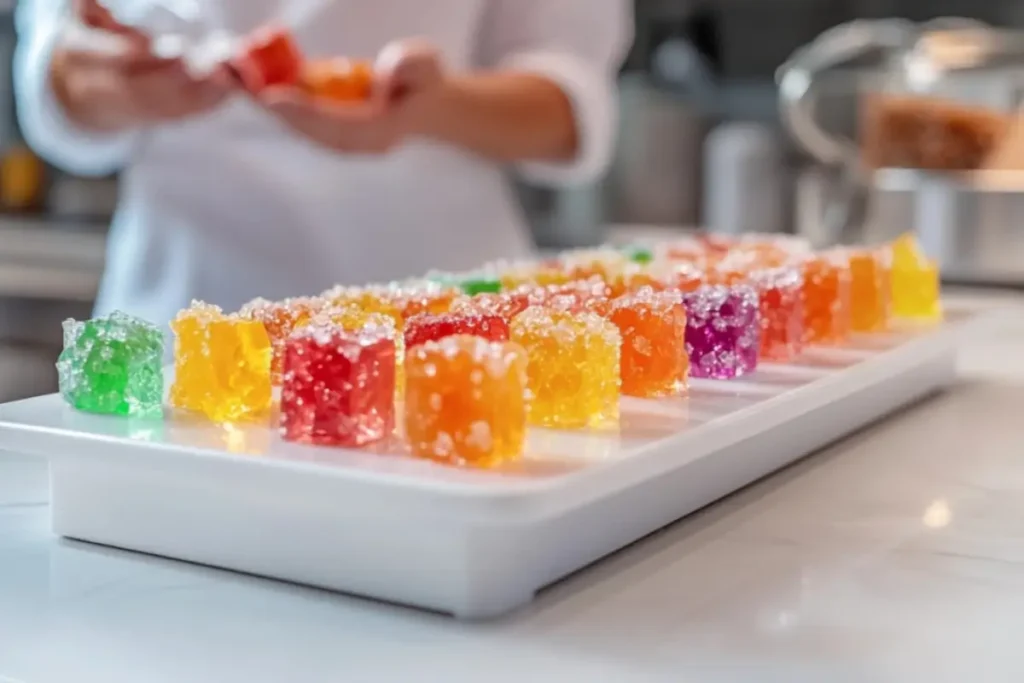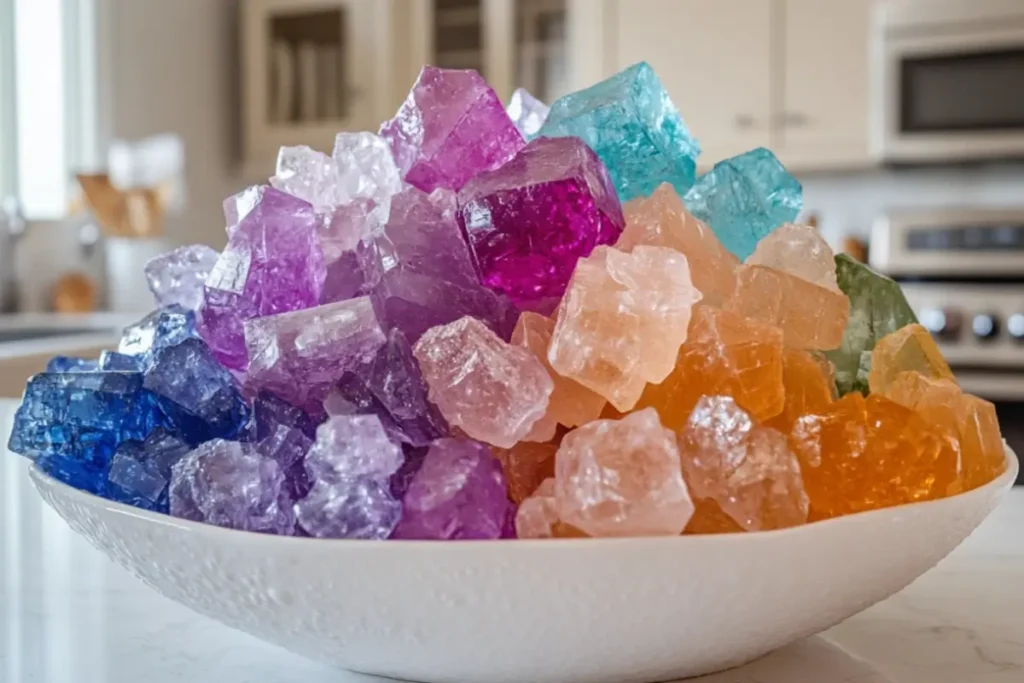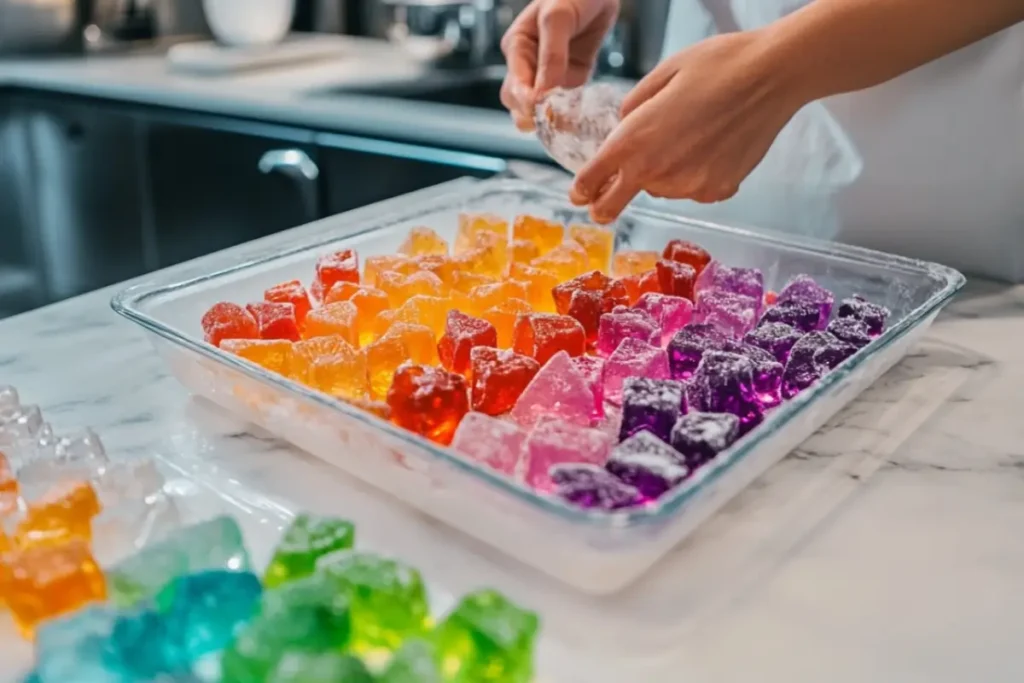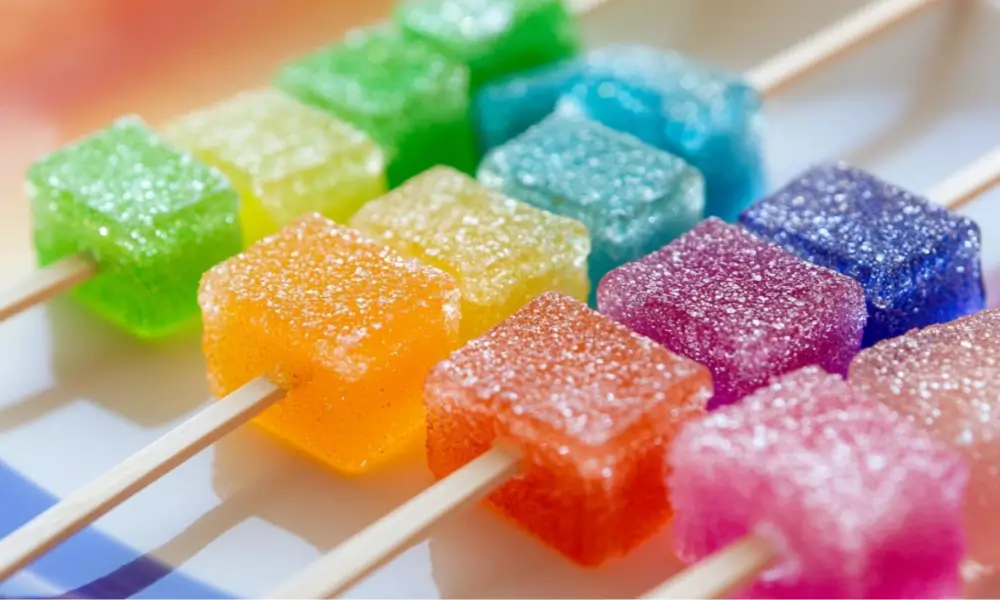Ever been captivated by the dazzling beauty of crystal candy? These sparkling, gem-like sweets seem to come straight from a fairy tale, don’t they? You’re not the only one enchanted! Crystal candy isn’t just a treat for the taste buds; it’s also a visual delight. From colorful rock candy sticks to finely crafted sugar crystals, this timeless confection has been adored for centuries, and it still holds a special place in the hearts of candy enthusiasts everywhere.
What truly adds to the allure of crystal candy is the process behind its creation. Watching basic ingredients evolve into beautiful, edible crystals feels almost like magic. Whether you’re enjoying it as a nostalgic treat from your childhood or using it to elevate your desserts, crystal candy has a unique way of capturing the heart.
A Brief History of Crystal Candy
Crystal candy isn’t just a contemporary wonder; it has an intriguing history that stretches back to ancient civilizations. Early discoveries of sugar crystallization were made in regions like China and the Middle East. In those times, it was regarded as a luxurious treat, savored by royalty and the elite.
Crystal candy has endured through the ages, providing not only a satisfying crunch but also a captivating sparkle.
During the Renaissance, European candy makers refined the craft of creating crystal candy, transforming it into a coveted treat in royal courts. Today, it has evolved from being a rare delicacy to an accessible, colorful treat loved worldwide. It’s often used for celebrations, gifts, and even as an ingredient in fancy cocktails.
Why Crystal Candy Is So Popular Today
So, why do people still love crystal candy today? Well, for starters, it’s an eye-catching treat perfect for special occasions. From wedding favors to party decorations, it adds a touch of elegance and fun. Making crystal candy at home can also be an enjoyable science experiment, perfect for both kids and adults!
Another reason for its popularity is its versatility. Whether you want a sweet snack, a drink garnish, or a beautiful cake decoration, this sugary delight fits the bill. Thanks to social media, crystal candy has become a popular DIY treat, with numerous recipes and tutorials flooding the internet.
What Is Crystal Candy Made Of?

Now, let’s get to the heart of the matter: What exactly is crystal candy made from? Surprisingly, it’s made from just a few simple ingredients you probably have in your kitchen. But don’t let its simplicity fool you—getting those perfect, glistening crystals requires a little patience and know-how.
Key Ingredients Used in Crystal Candy
The allure of crystal candy begins with selecting the perfect ingredients. Here’s a quick look at what you’ll need:
| Ingredient | Quantity | Purpose |
|---|---|---|
| Sugar | 2 cups | The base ingredient for crystal formation |
| Water | 1 cup | Dissolves sugar to create a syrup |
| Food coloring | Few drops | Adds vibrant color to the candy |
| Flavoring (optional) | 1 tsp | Enhances the taste |
| Wooden sticks or string | As needed | Used for crystal growth |
By combining these ingredients in the right proportions, you can create a super-saturated sugar solution that’s the foundation of crystal candy. And the best part? You have the freedom to personalize it with a variety of flavors and colors, according to your preference.
Natural vs. Artificial Ingredients
Wondering if natural ingredients make a difference? Some prefer using organic cane sugar and natural extracts for a healthier, more natural candy. On the other hand, artificial colors and flavors can help achieve those bright, fun colors that kids love.
“Using natural ingredients may take longer to crystallize but results in a more authentic flavor profile.”
Keep in mind that artificial ingredients can sometimes accelerate the crystallization process, helping beginners achieve more consistent results. If you’re after health-conscious options, try using fruit-based dyes and essential oil extracts for natural flavoring.
How Different Ingredients Affect the Texture and Flavor
The texture of crystal candy depends on factors like sugar concentration, cooling speed, and even humidity levels. For example, adding more sugar can lead to larger, chunkier crystals, while certain flavorings may slow down the crystallization process. Trying out different ingredients can lead to a range of results, from smooth and shiny to textured and crunchy.
For a softer bite, some people prefer adding a bit of corn syrup to the mixture, which helps prevent crystals from becoming too hard. Meanwhile, using brown sugar instead of white sugar can create a deeper, more caramel-like flavor.
The Process of Making Crystal Candy
Making crystal candy is part science, part art. The process involves making a supersaturated sugar solution and letting it cool, allowing stunning crystals to form gradually. Here’s a simple step-by-step guide to help you create your own at home.
Step-by-Step Guide to Making Crystal Candy at Home
- Make the sugar solution: In a saucepan, mix sugar and water. Heat over medium, stirring continuously until the sugar is fully dissolved.
- Add color and flavor: Once the sugar is dissolved, add your desired food coloring and flavoring. Stir well.
- Cool the mixture: Let it sit for 10-15 minutes to cool slightly before transferring it into jars or glasses.
- Insert sticks or strings: Dip wooden sticks or strings into the solution and allow the crystals to form over the next few days.
- Patience is key: Keep the jars in a cool, undisturbed place and watch the magic happen!
Within a week, you should notice gorgeous sugar crystals beginning to form around the sticks or strings. The longer you wait, the bigger and shinier they’ll get!
Industrial Production Process of Crystal Candy
On a larger scale, candy producers use specialized equipment to mass-produce these sugary delights. The process requires careful temperature management, automated stirring, and occasionally additives to accelerate crystallization. The end result? Consistently sized and shaped pieces ready for packaging.
Common Problems When Making Crystal Candy

Making crystal candy sounds easy, right? Just dissolve some sugar in water, let it cool, and voilà! But in reality, things don’t always go as planned. Sometimes the sugar won’t crystallize, or you might end up with sticky, cloudy candy that doesn’t look as appealing as you’d hoped. The good news? Most issues have simple fixes, and with a bit of patience, you’ll get those perfect sparkling crystals.
Why Does My Crystal Candy Not Form Properly?
One of the most common issues is that crystals fail to form. If you’re facing this problem, it’s likely due to:
- Not enough sugar: The solution must be supersaturated, meaning it should contain more sugar than the water can hold at room temperature. If the sugar-to-water ratio is off, the crystals won’t develop.
- Impurities in the water: Tap water can contain minerals and impurities that interfere with crystallization. Always use distilled or filtered water for better results.
- Temperature issues: If the solution cools too quickly or is exposed to sudden temperature changes, crystallization might not occur correctly.
- Container contamination: Any leftover grease or soap residue in your container can prevent crystals from forming. Make sure everything is clean before you start.
“Crystallization is a delicate balance—too little sugar or too much disturbance can ruin the entire process.”
How to Prevent Sugar Crystallization Issues
If you’ve ever ended up with a clumpy mess instead of sparkling candy, don’t worry—you’re not alone! Sugar crystallization can be tricky to control. Here are a few tips to avoid mishaps:
- Stir with care: Overstirring can introduce air bubbles and impurities, causing unwanted grainy textures.
- Use clean utensils: Any grease or residue can disrupt the formation of uniform sugar crystals.
- Let it cool undisturbed: Once you’ve poured the solution into jars, leave it alone to avoid disturbing the delicate crystallization process.
- Use seed crystals: Adding a small crystal of sugar or a pre-grown crystal can help jumpstart the process.
Troubleshooting Cloudy or Sticky Crystal Candy
Cloudy or sticky candy can occur if the sugar solution wasn’t prepared properly. If your candy looks dull rather than crystal clear, consider these factors:
- Humidity: High moisture levels in the air can cause the crystals to absorb water and become sticky.
- Overheating: Boiling the sugar mixture for too long can result in caramelization, which affects the clarity of the crystals.
- Incorrect storage: Once the candy has formed, it needs to be stored in an airtight container to prevent it from absorbing moisture.
Another useful trick is to lightly dust finished candy with powdered sugar or cornstarch to prevent stickiness.
Tips for Perfect Crystal Candy Every Time

Want to make crystal candy like a pro? Here are a few expert tips to help you achieve perfect results:
Choosing the Right Ingredients
Quality matters when it comes to crystal candy. Here’s what to keep in mind:
- Use pure granulated sugar: This type of sugar dissolves evenly and creates clear, beautiful crystals.
- Opt for high-quality flavorings: Natural extracts provide a better flavor compared to artificial ones.
- Coloring considerations: Gel-based food colors are better than liquid ones, as they don’t dilute the sugar solution.
- Avoid using honey: It contains impurities that can interfere with crystallization.
Best Storage Practices to Maintain Freshness
Crystal candy can last for a long time if stored correctly. Here’s how you can keep it fresh and shiny:
- Store in an airtight container away from moisture and direct sunlight.
- Place silica gel packets in the container to absorb excess humidity.
- Avoid refrigeration, as temperature fluctuations can cause condensation.
Is Crystal Candy Healthy? Nutritional Facts
Crystal candy is undeniably delicious, but how does it stack up nutritionally? Let’s break it down.
| Nutrient | Per 1 Stick (28g) |
|---|---|
| Calories | 110 |
| Sugar | 27g |
| Fat | 0g |
| Protein | 0g |
| Carbohydrates | 28g |
Healthier Alternatives and Sugar-Free Options
If you’re looking for a healthier version, consider using sugar substitutes like:
- Stevia: A natural, zero-calorie sweetener.
- Xylitol: A low-calorie sweetener that’s tooth-friendly.
- Erythritol: A sugar alcohol with a similar texture to sugar.
Fun Ways to Use Crystal Candy
Crystal candy isn’t just for snacking—it’s also great for:
- Decorating cakes, cupcakes, and cookies with colorful crystal sprinkles.
- Stirring into drinks like lemonade or cocktails for added sweetness and sparkle.
- Gifting in beautifully wrapped jars as a homemade present.
Comparison with Other Types of Candy
Unlike chewy caramels or hard lollipops, crystal candy is all about texture and visual appeal. Its crunchy outside and jelly-like interior make it stand out. While other candies rely on caramelization for flavor, crystal candy focuses on its crystal-clear design and light, refreshing taste.
For more fascinating dessert science, check out our guide on other creative dessert recipes here. It’s packed with unique ideas to inspire your next treat!
Frequently Asked Questions
How Long Does Crystal Candy Last?
When stored correctly, crystal candy can last for up to 6 months to a year without losing its shine or crunch. The key is to keep it in an airtight container and away from moisture. Exposure to humidity can make it sticky and cause it to dissolve over time.
Can Crystal Candy Be Made Without Sugar?
Yes, it’s possible to make crystal candy using sugar substitutes like stevia, erythritol, or xylitol. However, the crystallization process may take longer or result in different textures compared to traditional sugar-based candy. Sugar substitutes don’t always behave the same way, so expect a bit of trial and error.
What Are the Best Flavors for Crystal Candy?
Crystal candy can be customized with a variety of flavors to suit your taste preferences. Some popular choices include:
- Fruity flavors: Strawberry, lemon, orange, and blueberry.
- Minty flavors: Peppermint or spearmint for a refreshing touch.
- Floral flavors: Lavender, rose, or jasmine for a unique twist.
- Classic flavors: Vanilla, almond, or caramel.
The flavoring should be added after dissolving the sugar to preserve its taste and avoid evaporation due to heat.
Can I Speed Up the Crystalization Process?
Patience is key when making crystal candy, but if you’re short on time, you can try these tips to speed up the process:
- Place the jars in a warm, dry spot to encourage faster evaporation.
- Add a “seed crystal” to kickstart the growth process.
- Ensure the sugar concentration is high enough for rapid crystallization.
Keep in mind that speeding up the process too much can sometimes result in smaller, less defined crystals.
Why Is My Crystal Candy Sticky?
If your crystal candy turns sticky, it’s likely due to:
- Humidity: High moisture in the air can make the candy absorb water.
- Insufficient drying: Make sure the candy is fully dry before storing.
- Storage issues: Use airtight containers to prevent exposure to moisture.
To fix sticky candy, try placing it in a low-temperature oven for a few minutes to remove excess moisture.
Can I Use Brown Sugar Instead of White Sugar?
While it’s possible to use brown sugar, the results will differ. Brown sugar contains molasses, which can affect the crystallization process and produce a more caramelized, slightly chewy candy rather than the clear, crisp crystals you get with white sugar.
What Should I Do If My Crystal Candy Tastes Burnt?
A burnt taste usually means the sugar syrup was heated for too long or at too high a temperature. To avoid this, always monitor the heat carefully and use a candy thermometer if possible. The ideal temperature for dissolving sugar without caramelization is around 230-250°F (110-120°C).
Is Crystal Candy Safe for Kids?
Crystal candy is generally safe for children but should be enjoyed in moderation due to its high sugar content. It’s also important to ensure that small crystals are not a choking hazard for younger children.
Can I Use Crystal Candy to Decorate Cakes?
Absolutely! Crystal candy makes a beautiful decoration for cakes, cupcakes, and cookies. It adds a sparkling touch and an extra bit of sweetness. Just make sure to add it shortly before serving to prevent it from dissolving due to moisture from frosting.
Can Crystal Candy Be Used in Drinks?
Yes! Crystal candy sticks make excellent stirrers for hot beverages like tea and coffee, and they can also add a decorative touch to cocktails. The sugar dissolves gradually, giving your drink a hint of sweetness with each stir.
Why Are My Crystals Too Small?
If your crystals are too small, it could be because the solution cooled too quickly, or there wasn’t enough sugar in the mixture. To encourage larger crystals, try:
- Letting the solution cool slowly at room temperature.
- Using a more concentrated sugar solution.
- Avoiding disturbances during the crystal growth phase.
How Can I Add a Sparkling Effect to My Crystal Candy?
To achieve an extra sparkle, lightly dust your finished candy with edible glitter or shimmer dust. You can also try using clear flavors and colorings to enhance the natural shine of the crystals.
What Is the Science Behind Crystal Candy?
Crystal candy is a fun way to learn about saturation, solubility, and crystallization. When sugar dissolves in water, it forms a solution. Heating the solution allows it to hold more sugar than it normally would at room temperature, creating a supersaturated solution. As it cools, the sugar molecules start to arrange themselves into solid crystal structures.
“Making crystal candy is like conducting your own sweet science experiment at home!”
Can I Add Edible Flowers or Herbs to Crystal Candy?
Yes! Adding dried edible flowers like rose petals or herbs like mint can give your crystal candy a unique look and flavor. Just be sure to use food-safe, organic options to avoid any harmful chemicals.
Final Thoughts
Crystal candy is a delightful treat that combines science, art, and a whole lot of sweetness. Whether you’re making it for fun, as a gift, or to decorate your desserts, the process is just as enjoyable as the final product. Plus, with so many flavors and colors to experiment with, the possibilities are endless!
So, why not give it a try? With the right ingredients, a little patience, and these handy tips, you’ll be creating your own sparkling crystal candy masterpiece in no time. Happy candy-making! 🍬✨


